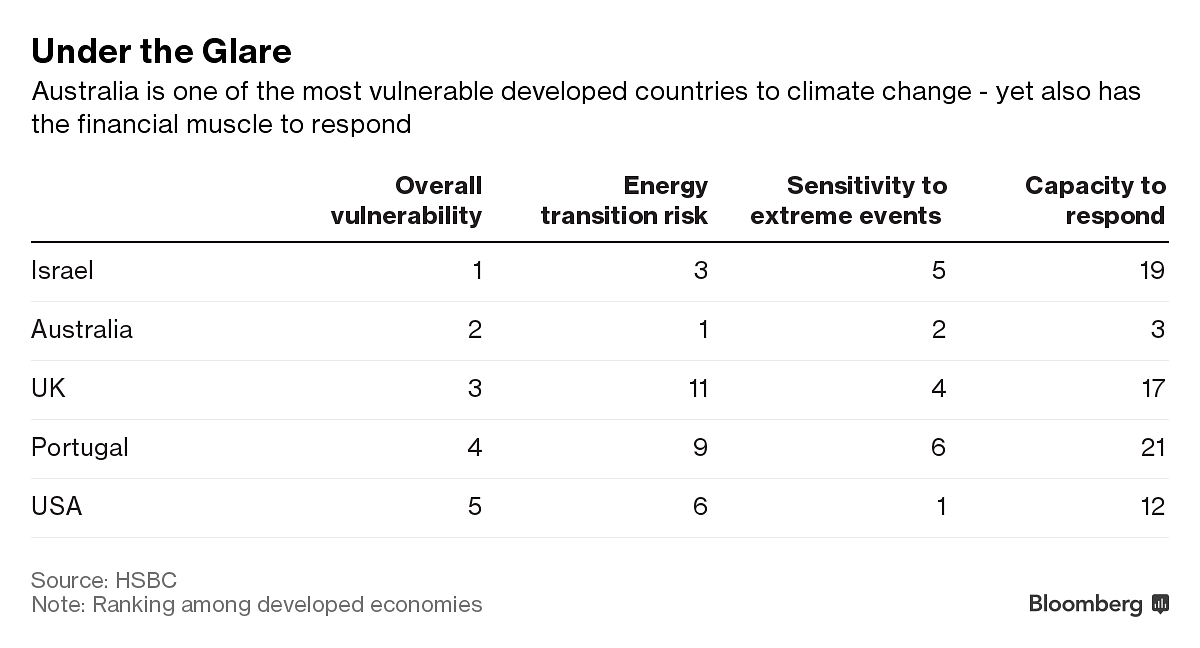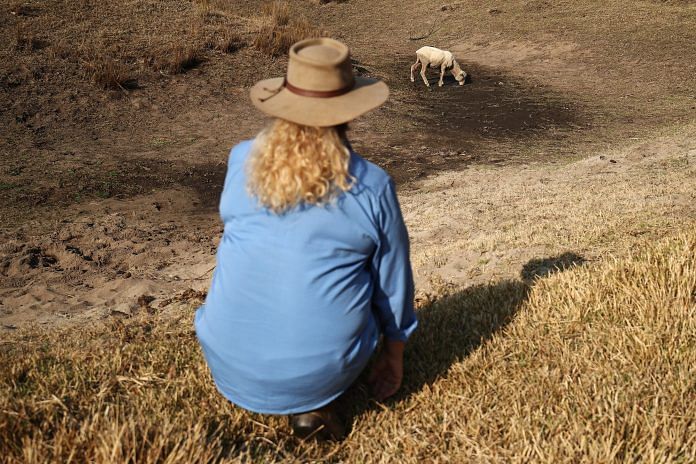Economists estimate the drought could cut as much as 0.75 per cent from gross domestic product growth.
Sydney: From cooling showers for cows to airport runways designed for higher sea levels, businesses and parts of Australia’s A$2.7 trillion ($2 trillion) pension industry are starting to find ways to live with rising temperatures.
In the world’s driest inhabited continent, enduring a devastating drought that arrived in mid-winter, private action to prepare for climate change contrasts with years of division on energy and environmental policies. Australia’s latest climate casualties are its farmers, who are being forced to slaughter livestock and watch crops wither amid one of the worst droughts on record.
Leeanne Oldfield has abandoned expansion plans and the few dozen malnourished sheep that remain of her 300-strong flock can’t even drink from the dam anymore, as it has gone dry.
“In good years, this is usually full to the brim with water,” says Oldfield on her farm three hours’ drive from Sydney, pointing to the muddy pit where the dam should be. Frustrated by a lack of government action, she’s helped organize donations of truckloads of hay and grain to other farms.

“Farmers in this country are getting desperate, they’re on their knees,” said Oldfield.
Dry conditions are set to continue with eastern states including New South Wales — the most populous and the powerhouse of the economy — the worst affected. Economists estimate the drought could cut as much as 0.75 per cent from gross domestic product growth.
Shortly after taking over as prime minister last month, Scott Morrison got on a plane and toured a drought-stricken farm in Queensland, announcing measures to aid the stressed agricultural sector. Yet as for broader climate policy, Australia appears as far away as it has ever been from a consensus on what should be done.
“The staggering thing is we aren’t leading the world,” said John Hewson, former leader of the now ruling Liberal Party who has worked as an economist for the Reserve Bank and the International Monetary Fund. “We should be showing them what can be done and the business opportunities from that in terms of investment, in terms of jobs, in terms of growth, are very significant. And they’ve just been cast aside like they don’t matter.”
The road block: politics. Morrison came to the prime ministership after months of toxic infighting over energy policy saw Malcolm Turnbull lose a leadership vote that resulted in the nation’s sixth change of leader in 11 years. The new prime minister — who once brandished a chunk of coal in parliament as a show of allegiance to that sector — quickly ditched Turnbull’s contentious plan to lock in carbon emission reductions, leaving the government with no settled energy policy ahead of an election that must be called by May.
With Australia battling bush fires in winter and the Great Barrier Reef facing slow destruction due to coral bleaching, voters want action. An Australia Institute poll this month showed that 73 percent of Australians are concerned about climate change, up from 66 percent last year. And just over half of people surveyed think governments aren’t doing enough.
Poisonous politics is also hitting business. Australia’s total investment in clean energy soared to a record $9 billion last year, largely driven by a rush to fulfill a government target that winds down in 2020. Investment will fall off a cliff over the coming years unless there is a major change in government policy, according to Bloomberg New Energy Finance.
“The government has revived the default approach the Liberal-National coalition has had on emissions since the 1990s: do as little as possible, hope that economic developments reduce emissions without policy intervention, deny that there are any policy issues, and defer as many issues as possible to another day,” said Kobad Bhavnagri, head of BNEF research for Australia. “It’s akin to having one’s fingers crossed and head buried in the sand.”
For Australia’s pension funds, the lack of certainty surrounding climate policy is a problem because they often need to plan decades ahead. With infrastructure assets in particular, which investors may wish to hold indefinitely, ensuring they’ll still be operational and profitable in a changed climate is vital.
“Climate change is here and the impacts are being felt,” said Emma Herd, chief executive officer of the Investor Group on Climate Change, whose members control about A$2 trillion in investments. “Large sections of the private sector are moving in concert with global change and not being driven by domestic regulatory pressures.”
Meantime, Australian firms are developing cutting-edge tools that allow investors to model how climate change will impact precise areas where they have an asset, says Herd. Nick Wood, director of consultancy Climate Policy Research, says the private sector’s attitude has “definitely changed.”
IFM Investors, a A$111 billion infrastructure fund, has taken steps to safeguard assets against environmental change. It part owns Brisbane Airport, which built a new water side runway 1.5 meters higher than regulation demands. The fund is also offering lower berthing fees at its ports to less-polluting ships.
Construction & Building Unions Superannuation, a A$46 billion Australian fund, has committed to making all of its properties have net zero emissions by 2030.
“While Australia is locked in a policy quagmire on climate action, the world is moving on and this makes sound investment and economic sense,” said Kristian Fok, CBUS’s chief investment officer.
On her dairy farm 700 kilometers inland from Sydney, Ruth Kydd says there is only one answer: prepare now. To prevent dairy production dropping as cows become heat stressed, she’s installed sprinklers for them to cool off under, and stored at least six months supply of feed. That’s put her in a stronger position than many to fight the drought.
“All our decisions have a long-term aspect to them, otherwise it’s not worth investing the money,” she says. How the climate will look in a decade or more “is always in the back of your mind.” – Bloomberg



